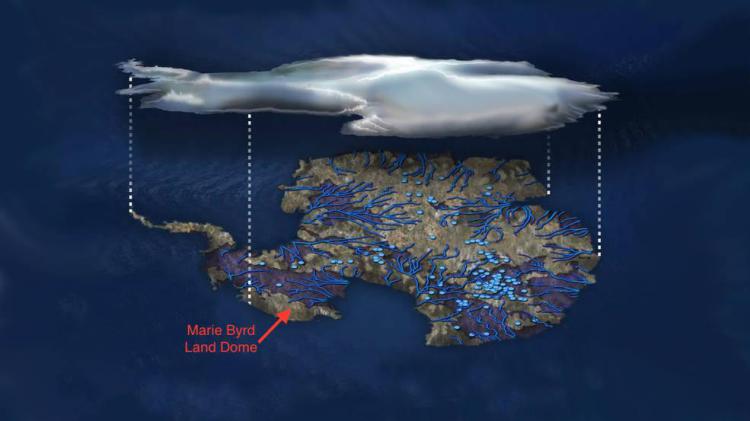A mantle plume producing almost as much heat as Yellowstone supervolcano appears to be melting part of West Antarctica from beneath.
Researchers at NASA have discovered a huge upwelling of hot rock under Marie Byrd Land, which lies between the Ross Ice Shelf and the Ross Sea, is creating vast lakes and rivers under the ice sheet. The presence of a huge mantle plume could explain why the region is so unstable today, and why it collapsed so quickly at the end of the last Ice Age, 11,000 years ago.
Mantle plumes are thought to be part of the plumbing systems that brings hot material up from Earth's interior. Once it gets through the mantle, it spreads out under the crust, providing magma for volcanic eruptions. The area above a plume is known as a hotspot.

Marie Byrd Land.
NASA/MICHAEL STUDINGER
For 30 years, scientists have suggested that a mantle plume may exist under Marie Byrd Land. Its presence would explain the regional volcanic activity seen in the area, as well as a dome feature that exists there. However, there was no evidence to support this idea.
Now, scientists from NASA's Jet Propulsion Laboratory have created advanced numerical models to show how much heat would need to exist beneath the ice to account for their observationsincluding the dome and the giant subsurface rivers and lakes we know are present on Antarctica's bedrock. As lakes fill and drain, the ice thousands of feet above rises and falls, sometimes by as much as 20 feet.
Study author Hélène Seroussi, from JPL, said when she first heard that a mantle plume might be heating Marie Byrd Land she thought the idea was "crazy."
"I didn't see how we could have that amount of heat and still have ice on top of it," she said in a statement.
However, in a study published in the Journal of Geophysical Research: Solid Earth, Seroussi and colleagues looked at one of the most well studied magma plumes on Earththe Yellowstone hotspot. The team developed a mantle plume model to look at how much geothermal heat would be needed to explain what is seen at Marie Byrd Land. They then used the Ice Sheet System Model (ISSM), which shows the physics of ice sheets, to look at the natural sources of heating and heat transport.
This model enabled researchers to place "powerful constraint" on how much melt rate was allowable, meaning they could test out different scenarios of how much heat was being produced deep beneath the ice.

Illustration of flowing water under the Antarctic ice sheet. Blue dots indicate lakes, lines show rivers. Marie Byrd Land is part of the bulging "elbow" leading to the Antarctic Peninsula. NSF/ZINA DERETSKY
Their findings showed that generally, the energy being generated by the mantle plume is no more than 150 milliwatts per square meterany more would result in too much melting. The heat generated under Yellowstone National Park, on average, is 200 milliwatts per square meter.
Scientists also found one area where the heat flow must be at least 150-180 milliwatts per square meterbut data suggests mantle heat at this location comes from a rifta fracture in the Earth's crust where heat can rise up.
Concluding, the team say the Marie Byrd Land mantle plume formed 50-110 million years agolong before the land above was hidden by ice. Heat from it, they say, has an "important local impact" on the ice sheetand understanding these processes will allow researchers to work out what will happen to it in the future.